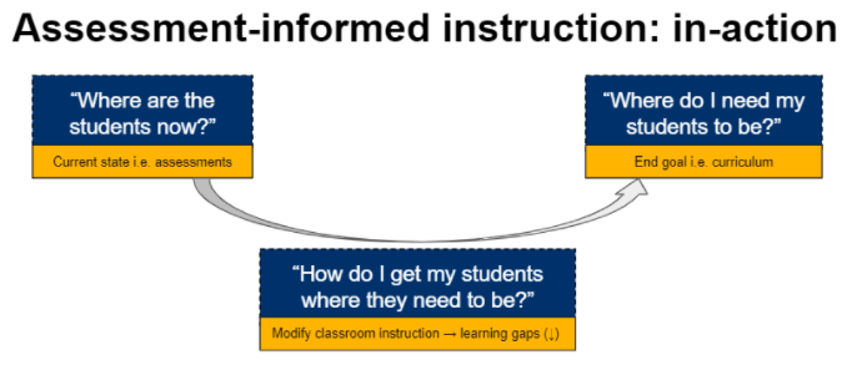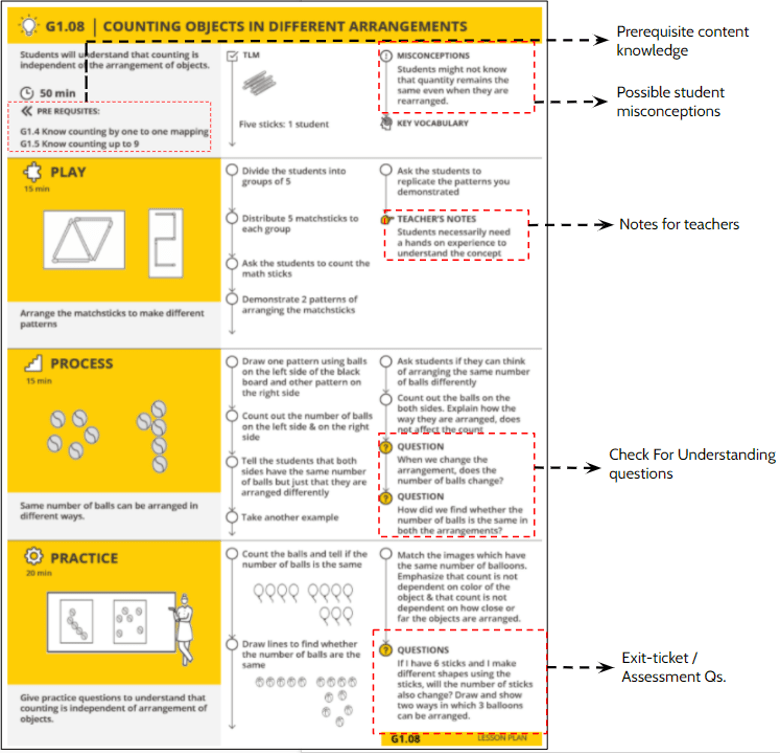 Go Back
Go BackShare
Assessment-Informed Instruction-101: A Guide for Practitioners
By Shivam Rawal
Mar 27, 2022
If a doctor cannot prescribe medicines without gathering, interpreting, and diagnosing a patient's health problem—why is the equivalent of this acceptable in education? Unfortunately, teachers often don’t have the time, tools, and capabilities to continuously understand the current learning level of all students and tailor their support accordingly, and so many children get left behind. A critical missing link is an assessment-informed instruction (A-i-i) approach to identify “where students are” and “how best to move them to their intended destination”.
If a doctor cannot prescribe medicines without gathering, interpreting, and diagnosing a patient’s health concerns—why is the equivalent of this acceptable in education?
Teachers don’t have the time, tools, or capabilities to regularly gauge the learning levels of students and tailor their support accordingly which is why many students often get left behind. Assessment-Informed Instruction (A-i-i) is that missing link which helps teachers identify “where students are” and “how best to move them to their intended destination” through the modification of teaching and learning activities in the classroom. It involves supporting teachers with a step-by-step guide integrated within the teaching-learning materials with regular checkpoints to assess the learning levels of students and instructions tailored according to the students’ responses.
Assessment-Informed Instruction (A-i-i) is that missing link which helps teachers identify “where students are” and “how best to move them to their intended destination” through the modification of teaching and learning activities in the classroom.
Many education systems around the globe have undertaken some form of assessment-led reform to measure student learning outcomes, yet only measurement of learning is not sufficient. For assessment to inform instruction and improve learning outcomes, it must be followed by action. Hence, it is essential to support teachers in customizing classroom instruction practices based on the learning needs of the students.

Though the central actor to drive A-i-i in the classroom is the teacher, successful integration of A-i-i in the classroom would depend on how well education practitioners support the teacher to package A-i-i within the following four pillars of the program: (1) Teaching-Learning Materials (TLMs), (2) Teacher Professional Development (TPD), (3) Academic Support, and (4) Program Design and Systems.
How can education practitioners support teachers to use A-i-i to improve learning in their classrooms?
1. Teaching-Learning Materials
A-i-i requires teachers to identify students’ learning needs and make real-time instructional decisions based on students’ responses. Hence, practitioners developing teaching-learning materials must ensure that the teachers are supported with a step-by-step pedagogical routine to integrate A-i-i at various stages of instruction. In addition, the instructional tools must have checkpoints within a lesson to check for students’ understanding and suggestions to make this possible.

CSF, in collaboration with its academic partners in Mission Prerna, Uttar Pradesh (Language and Learning Foundation and Vikramshila Education Resource Society) and Mission Ankur, Madhya Pradesh (Room to Read and Sol’s Arc), has embedded the elements of assessment-informed-instruction (A-i-i) in the lesson plans, worksheets, and weekly structure, contributing towards reform in instructional routine and teacher practices.
2. Teacher Professional Development
Teachers vary in their capability to understand the purpose of assessment and apply various assessment strategies in the classroom. Accordingly, a dedicated training module is needed to orient teachers on the materials as per the program design of the implementation partner. Teachers who may be new to A-i-i might not understand that A-i-i isn’t equal to conducting assessments or filling trackers. Others may confuse A-i-i with just assessing more frequently. Hence, it becomes vital to clarify teachers’ misconceptions and build their knowledge, skills, and mindset to generate buy-in to A-i-i.
3. Academic Support
Together with forming academic support for teachers—trainers and coaches play a crucial role in bridging the gap between teachers’ prior experiences and A-i-i practices, ensuring effective implementation of A-i-i in the classroom. While teacher-training/TPD can be used as a ‘how-to-use’ layer for A-i-i practices in TLMs, the coaching-mentoring can be used to check if teachers are able to effectively implement A-i-i strategies inside the classroom. Additionally, as coaches/mentors have multiple touchpoints with teachers through classroom observation, the academic support cadre can ensure teachers receive regular feedback and practice on A-i-i.
4. Program Design and Systems
To successfully embed A-i-i within the program design and system, program leaders must provide structures that enable teachers to absorb A-i-i practices into habit change. There are multiple ways to build a pedagogical routine—it can be at a weekly level, provide an overall structure of the week, allocate particular days for assessment, and support students based on the assessment results. For instance, Language and Learning Foundation in Haryana embeds a dedicated 4+1+1 weekly structure: classroom instruction on Day 1-4, weekly assessment on Day 5, and remediation on Day 6. Teachers are supported by having this structure in the teacher guide, and it maps to the corresponding worksheets in the student workbook to be used every week.

To supply more details on the above recommendations, CSF is releasing a Practitioner’s Guide to embedding A-i-i, which serves as a last-mile solution for education stakeholders in this critical global agenda. The first half of the guide lists recommended interventions for each actor of A-i-i—instructional and curriculum designers, teachers, trainers, coaches and mentors, program leaders, and government. The second half of the guide summarizes best practices and evidence of the recommendations from around the world.
Finally, while there are localized examples of assessment-informed instruction used successfully in low-and middle-income countries, more needs to be understood about how to scale these interventions to ensure that assessment-informed instruction happens more often and across whole systems, to improve learning outcomes for children around the world. The next milestone for us, as education practitioners, is to strengthen our programs by embedding A-i-i approaches within the existing systems to support teachers in improving their teaching.
View Article References
Keywords
Authored by
Shivam Rawal
Project Manager, CSF
Share this on
